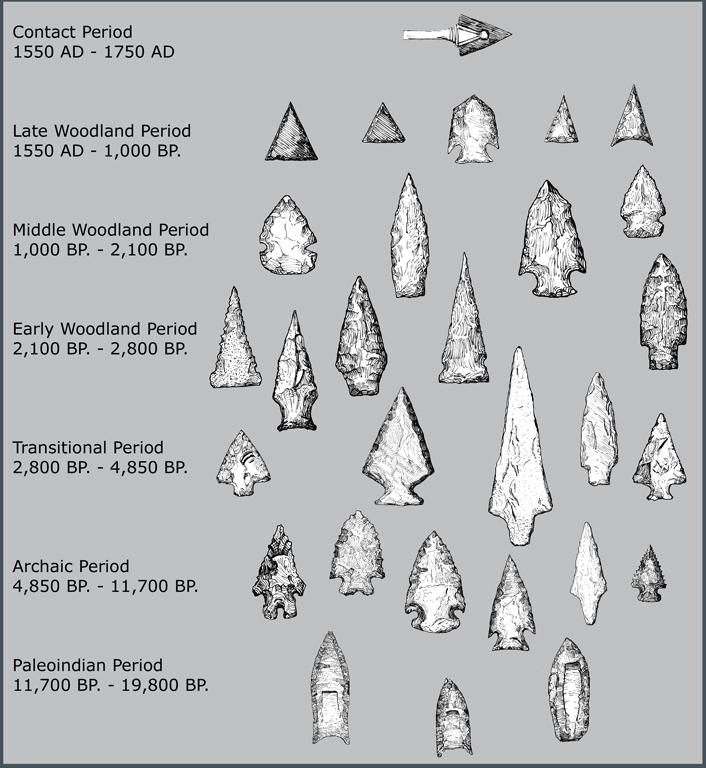Time Periods
What we know about prehistoric Native Americans in Pennsylvania comes from the scientific study of material remains, the study of archaeology. The evolution of Native American culture in this region has been divided into at least five time periods by archaeologists; each change is based on shifts in the archaeological record. It is believed that ancient people adapted tools to fit their lifestyle, and a transition in tools signals a change in how people lived, acquired food, organized their families, and practiced their religious beliefs.
Below is an outline of each time period and the distinctive traits.
Contact Period
(Susquehannocks and other historically recorded tribes) 1550 AD - 1750 AD
- Little Ice Age; generally cool or cold with periodic warm periods
- A time of cultural transition
- Native American tools are replaced with European equivalents
- Significant cultural boundaries exist between Europeans and Native Americans, and at times, they exploit each other for mutual gain
- By the mid-18th century, tribal life by Native Americans in Pennsylvania ends, a combined result of warfare and disease
Late Woodland Period
(Late Prehistoric) 1,000 BP. - 1550 AD
- End of the Medieval Warming and beginning of the Little Ice Age
- Native American populations reach their maximum size
- The bow and arrow becomes dominant tool for hunting; pottery becomes progressively thinner, more durable, and culturally distinctive; ornamental items appear, and stone and earthenware pipes become common
- Hunting, fishing and gathering of wild foods continues along with an increasing dependence on domesticated plants such as corn, beans and squash
- Farmsteads increase in size from a few houses to villages with a circular plan of fifty family size houses surrounding a central plaza; some villages in the Susquehanna valley consist of longhouses that include large extended families
Early and Middle Woodland Period
(Adena and regional equivalents; Hopewell and regional equivalents) 1,000 BP. - 2,800 BP.
- Warm and wet climate
- Possible decrease in populations, but data base is poor
- Fewer base camp movements and more permanent settlements
- Fired clay pottery is introduced to the tool assemblage
- Hunting and fishing continues, evidence of flour production from gathered seeds
- Gardening intensifies using a variety of plants such as maygrass, knotweed, chenopodium, squash and little barley.
- Extensive trade network in Ohio valley but less trade in eastern Pennsylvania
Transitional Period
(Terminal Archaic) 2,800 BP. - 4,850 BP.
- Warm and dry climate; less predictable food resources
- Hunting, gathering, fishing, and gardening; travel in territories of 25-75 miles
- Extensive trade network in the Middle Atlantic Region
- Population pressure results in significant technological changes including steatite bowls used as cooking containers and large, broad-bladed points/knives known as broadspears
- A system of trade partners functioned as a quasi-insurance policy in a climate where food procurement was less predictable
Archaic Period
4,850 BP. - 11,700 BP.
- Warm and wet climate; broad leafed nut-bearing trees filled the forests
- Populations steadily increased
- Tools consist of spears, spear thrower, axes for woodworking, net sinkers for fishing, and grinding stones for processing seeds and nuts
- Hunters and gatherers travel over smaller territories of 50-100 miles
Paleoindian Period
11,700 BP. - 19,800 BP.
- Cold and dry climate; open spruce and pine forests
- Populations are small family bands of approximately 15 individuals
- Tools consist of spears, hide scrapers, woodworking scrapers, knives, and choppers; cherts and jaspers are preferred over other stone materials due more durable edges
- Hunters and gatherers travel over large territories of 75-250 miles exploiting the most easily gathered foods
